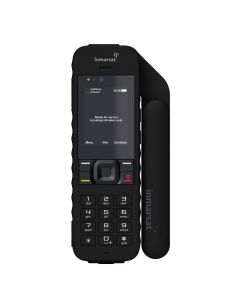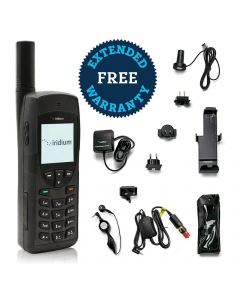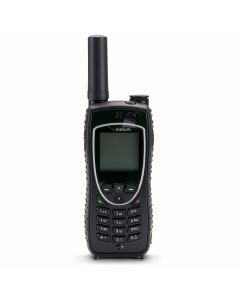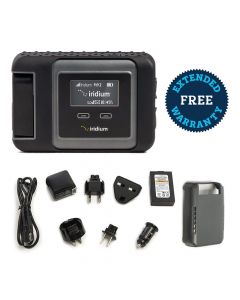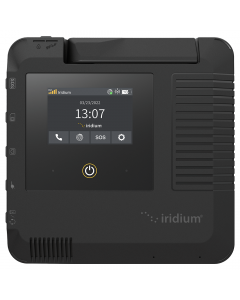Best Satellite Phones for Businesses
Compare Features, Costs & Reliability
2025 Satellite Phone Buyer's Guide
Choose the Best Satellite Phone & Equipment
Business buyers know the importance of choosing the best satellite phones and equipment to address their organizational user’s voice and data connectivity requirements. While leading satellite manufacturers like Iridium, Inmarsat, and Globalstar all offer a range of voice and data connectivity devices, there are important differences that enterprise buyers should consider. These may include the:
- Type of environment that the satellite phone or device needs to operate in
- Communications coverage required, based on the worksite or the region of travel
- Kind of connectivity users require
- Features required: voice, text, email, internet, check-in, SOS/personal safety, location awareness, tracking, navigation
- Data speeds the user or application require
It is important to remember that regardless of the specific features of any satellite phone, if it doesn’t offer reliable coverage in the region it will be used in, it won’t be useful.

What Is a Satellite Phone?
A satellite phone is a type of mobile phone. Like a cell phone, a satellite phone (also called a sat phone) is compact, lightweight and can be used for voice communication, text messaging and low-bandwidth Internet access (data). Some models of satellite phones also support Bluetooth and Wi-Fi, which allows the satellite phone to be used with a headset or connected to a laptop. However, there are some important differences between satellite phones and cell phones:
- Satellite phones communicate over a satellite-based network that resides in space whereas cell phones communicate via terrestrial (land-based) cell towers. Because sat phones transmit messages via satellites orbiting in space, satellite phones are designed to be used outdoors where the antenna can have a direct line-of-sight to the satellites in the sky. Cell phones can operate either indoors or outdoors, when in-range of cellular coverage.
- Most satellite phones have external antennas. Most cell phones have internal antennas. The antenna on a satellite phone needs to be deployed (extended) and have line-of-sight with the satellites in space, otherwise it will not be able to connect to the network and communicate.
- Some satellite phones offer a low bandwidth data connection, but the web browsing experience is nothing like what you’d experience using the high bandwidth connection offered by your smartphone. However, a satellite phone’s low bandwidth connection can be used for email, to send pictures, or download weather forecasts.
- Satellite terminals like Inmarsat, BGAN or Iridium GO! exec®, offer higher-bandwidth data capabilities than satellite phones, and are best suited to higher-bandwidth data needs
- Most satellite phones have special international phone numbers, though some networks like Globalstar, provide US or Canadian phone numbers. Other networks like Iridium also offer a feature called two-stage dialing that allows your contacts to call a US-based phone number, that automatically connects to your (international) satellite phone number. This is because many traditional phone carriers charge as much as $10 to place a call to a satellite phone number, so two-stage dialing (ie. calling a US number) makes it much more affordable to place a call to a satellite phone. Some providers also offer the option of getting a dedicated US number in addition to your satellite phone number, which makes it less expensive for callers to reach you.
In summary satellite phones and cell phones offer similar voice and data communications services, in different ways.
How Much Does a Satellite Phone Cost?
Best Satellite Phone Buyer's Guide 2025
The comparison chart below is designed to help you select the satellite phone best suited for your needs including quality of service (QoS), potential limitations, and advantages one satellite phone may have over another.
 |
 |
 |
 |
 |
|
| Compare | IsatPhone 2 | Iridium GO! | Iridium 9555 | Iridium Extreme | Iridium Extreme PTT |
|---|---|---|---|---|---|
| Learn More | View Details | View Details | View Details | View Details | View Details |
| Pricing (approx) | $789 | $855 | $1,150 | $1,450 | $1,605 |
| Network | Inmarsat | Iridium | Iridium | Iridium | Iridium |
| Coverage | Global (minus poles) | Global | Global | Global | Global |
| Weight | 11.14 oz (316 g) | 10.75 oz (305 g) | 9.38 oz (266 g) | 8.7 oz (247 g) | 9.5 oz (268 g) |
| Size | 6.65” x 2.95” x 1.14” (16.9 x 7.5 x 2.9 cm) |
4.5” x 3.25” x 1.25” (11.4 x 8.3 x 3.2 cm) |
5.63” x 2.17” x 1.18” (14.3 x 5.5 x 3.0 cm) |
5.5” x 2.36” x 1.06” (14.0 x 6.0 x 2.7 cm) |
5.5” x 2.36” x 1.2” (14.0 x 6.0 x 3.2 cm) |
| Battery Life | 8hrs talk / 160hrs standby | 5.5hrs talk / 15.5hrs standby | 3hrs talk / 30hrs standby | 4hrs talk / 30hrs standby | Phone mode: 6.5hrs talk / 54hrs standby PTT mode: 5hrs talk / 16.5hrs standby |
| Antenna | Fold-out directional | Flip-out | Retractable omni-directional | Retractable omni-directional | Retractable omni-directional |
| Display | Color | Monochrome | Monochrome | Monochrome | Monochrome |
| Durability | IK04 | MIL-STD 810F | N/A | MIL-STD 810F | MIL-STD 810F |
| Ingress Protection | IP65 | IP65 | N/A | IP65 | IP65 |
| Network | 3 geostationary satellites | 66 low earth orbit satellites | 66 low earth orbit satellites | 66 low earth orbit satellites | 66 low earth orbit satellites |
| Text Messaging (SMS) | Supported | Supported (with smarthpone app) | Supported | Supported | Supported |
| GPS | Yes | Yes | N/A | Yes | Yes |
| Push-to-talk (PTT) | N/A | Yes (with smarthpone app) | N/A | N/A | Yes |
| Interfaces | Micro USB, Bluetooth | Mini USB, audio | Mini USB, audio | Mini USB, audio | Mini USB, audio |
| Data Connectivity | Yes, via USB or AxcessPoint | Wi-Fi device ready | Yes, via USB or AxcessPoint | Yes, via USB or AxcessPoint | Yes, via USB or AxcessPoint |
| Data Speed (Uncompressed) | 2.4 Kbps | 2.4 kbps; up to 9.6 kbps with use of Iridium Mail & Web App | 2.4 Kbps | 2.4 Kbps | 2.4 Kbps |
| Emergency SOS | Yes | Yes (with smarthpone app) | No | Yes | Yes (in phone mode) |
| Learn More | View Details | View Details | View Details | View Details | View Details |
Which Satellite Phone Is Best?
The answer to this question depends on your needs. In addition to specific features and functionality that you may need, if you want a phone that will work anywhere in the world, an Iridium phone like Iridium 9555, Iridium Extreme or Iridium hotspot like Iridium GO!, or Iridium dual-mode device like Iridium Extreme PTT is best. If you’re not concerned about coverage in the polar regions, Inmarsat offers an excellent alternative, its IsatPhone 2 is that is also less expensive.
How Much Is Satellite Phone Service?
The cost of a satellite phone service depends on the type of service and the features. There are no long distance or roaming charges with the Iridium or Inmarsat satellite networks.
Monthly Service
Monthly satellite phone service guarantees 'always-on' access to airtime until the service is cancelled. It is a highly convenient option that is preferred by most business and government.
Monthly Satellite Phone PlansPrepaid Airtime
Prepaid satellite phone airtime is often more affordable but airtime expires. It can be can be a good option for short term seasonal use, or budget-conscious buyers.
Prepaid Satellite PhonesRentals
Sat phone rentals include equipment and airtime and are a great option for short-term projects, travel, or unanticipated requirements like emergency prep or disaster response.
Satellite Phone RentalsWho Uses Satellite Phones?
When satellite phones first came into use in the 1990s, they were quite expensive and therefore they were primarily used by government and organizations with remote operations, including: public safety, scientific research, oil and gas, mining, forestry, utilities, engineering, construction, transport, shipping and more. In 2007, lower-cost satellite messaging devices and personal trackers emerged, and consumer use of sat phones and text messaging devices grew as both devices and airtime became more affordable.
Today satellite phones and satellite messaging devices are used by outdoor enthusiasts and by businesses in a range of applications including: emergency preparedness and business continuity, remote mobile office, executive travel, and work alone check-in and safety monitoring.
How Does a Satellite Phone Work?
Satellite phones and cell phones both offer users voice and data connectivity. Like your cell phone, where a satellite phone will work, depends on the coverage offered by the satellite network and the airtime option you’ve selected.
Satellite phones can be a valuable back up to traditional phones because they operate independently of terrestrial communication or cell phone networks, which can be unreliable or non-existent in less populated regions and can be vulnerable to natural or man-made disasters.
Cell phones and smartphones operate over cellular networks and communicate via land-based (terrestrial) cell towers. Satellite phones operate over satellite networks, communicating via satellites that are either orbiting in a fixed location above the Equator (Inmarsat is an example of this geo-stationary (GEO) type of network), or in a low earth orbit (LEO) like the Iridium and Globalstar networks. The advantage of LEO networks is that the satellites orbit closer to space, meaning there is less latency than with a GEO network.
What is a Satellite Phone Used For?
Like other personal communication devices, satellite phones can be used for any voice, text messaging or data application. For consumers this includes personal safety and connectivity in the back-country or around the globe where cell coverage may be unavailable or unreliable.
Satellite Phone Accessories and Docking Stations
Satellite phones can also be used to make and receive satellite calls inside a building, vehicle, plane or boat provided they are used with specialized accessories like a compatible docking station or external antenna.

In-building Solutions
Use satellite phones in-building (including PBX integration), remote camp, or trailer.
View ProductsIn-vehicle Solutions
Use satellite phones in a car, truck, mobile command center or emergency vehicle.
View ProductsDo Satellite Phones Work Indoors?
Generally, satellite phones are designed to work outdoors, out-of-the box. Accessories can extend their utility to use indoors. To transmit, the satellite phone’s antenna must have an unobstructed direct line-of-sight with the satellites orbiting above Earth, which means the phone/antenna must be outdoors. However, most satellite phones can be used with specialized equipment like an external antenna, which enables use of a satellite phones in a building, vessel or vehicle. A cell phone can be used indoors provided it is in range of coverage, although some materials like thick concrete, steel and iron can obstruct cell signals in some indoor environments.
Where Can I Buy a Satellite Phone?
Satellite phones can be purchased from online stores like Bluecosmo or specialized dealers and retailers.
Find a Satellite Phone
